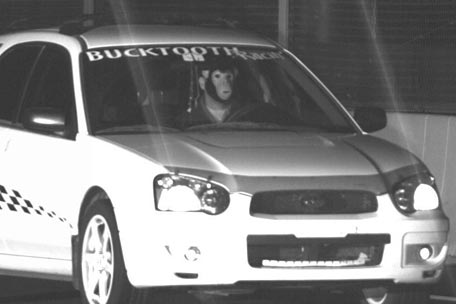Arizona: Speed Camera Company Makes A Monkey Out of Driver ID Regs
According to the Arizona Department of Public Safety (DPS) and Redflex Traffic Systems, a stringent review process guarantees the accuracy of every citation issued under the statewide photo radar program introduced last year. Evidence obtained this week from a confidential Redflex ticket processing manual, however, suggests that the state police and its Australian contractor may be misleading the public with such claims. “Redflex employees under our contract review the civil queue,” DPS Lieutenant Jeff King explained in a written presentation on the photo ticketing program. “If a driver can be identified based on comparisons of the license description and ‘flash photo,’ they accept the violation and a Notice of Violation is automatically printed and mailed. If photo quality is poor or face is blocked, etc., it will be rejected and placed in dormancy.”
This public statement is directly contradicted by the actual procedure described in the Redflex Procedural Manual for the Department of Public Safety, a document dated April 21, 2009 and obtained by the group CameraFraud.com. Under the heading ‘Special Notes,’ the manual outlines procedures designed to make it possible to issue tickets even when the facial photos are unclear.
“Do not reject any incidents for face issues if we can capture the plate image, send to batch,” the manual states. “If you can capture the plate image and not the face image, do not reject — send to batch.”
The next instruction suggests if more than half of the face is obstructed and the driver “would not be recognizable in person,” then the employee should reject the photo. It is important to note the distinction between having a facial photo for the citation and having a correctly identified facial photo.
Redflex is not penalized in any way for accusing the wrong person of an offense. If there is a mismatch between the sex of the driver photographed and the DMV record of the person to be accused of the violation, the Redflex manual says “Issue citation? YES.” Likewise with cases that involve an obvious age mismatch and cases where, for example, the registered vehicle is a Dodge but the violation photograph shows a Ford.
“If you have a gender mismatch, check the white box in the ‘More’ screen to see if there is another registered owner info that matches the gender,” the Redflex manual explains. “If there is registered owner info that matches the driver’s gender, add that info. If not, mark corporate/incomplete and leave any and all driver’s license and date of birth info.”
In other words, instead of automatically rejecting all tickets with obviously incorrect information — as the DPS public statements indicate is the correct procedure — the system is designed so that Redflex sends incomplete tickets to DPS in the hopes that the agency will approve the citation regardless.
It is obvious that Redflex, which is compensated on a per-ticket basis, wants to see DPS allow as many tickets as possible to be mailed to vehicle owners. The concern for maximizing ticket volume is found everywhere in the manual; the word ‘safety’ is never mentioned. This matches statements made by the company to investors.
“High-performance cameras increase prosecution rates and revenue streams,” Redflex CEO Graham Davie explained at an Australian shareholder meeting on November 30, 2006.
In statements to the press, Redflex has boasted that before any citation is forwarded to DPS, multiple human employees carefully examine the evidence to ensure it is a clear and unquestionable violation. Contract provision 8.10.2 requires “a second employee to review all violation images to ensure no misread registration plates will result in faulty citations.”
If the Advanced Quality Assurance third-level review process mentioned in Redflex sales material and contracts actually takes place, it is not described in the work flow chart described in the manual.
[ Click here for monkey man story. Thanks to Dangerous Dave for the link]
More by The Newspaper
Latest Car Reviews
Read moreLatest Product Reviews
Read moreRecent Comments
- Nathan The Ram is the most boring looking of the full size trucks, kind of like a Tundra.If they cancel the Ram Classic, I hope a full resign makes the Ram at least look interesting.
- DJB1 I'll be all for it when it has a proven safety record. I have an awesome life and a lot to live for, so right now I'm not putting that in the hands of overconfident tech-bros.
- Mgh57 I had to read the article because I had had no idea what the headline meant. I've never seen this in the Northeast. Don't understand the point. Doesn't seen efficient aerodynamically
- MaintenanceCosts Depends on the record of the company developing them. If it’s got a record of prioritizing safety over years of development, I’ll be fine with it, and I’ll expect it to be less risky than typical idiot human drivers. If it’s a “move fast and break sh!t” outfit like Tesla or Uber, no way.
- Kwik_Shift_Pro4X No thanks. You'll never convince me that anybody needs this.


































Comments
Join the conversation